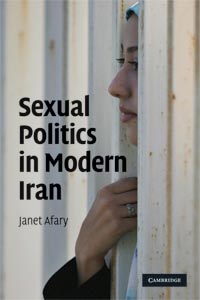Doug Ireland, writing for In These Times, recently published an excellent review of Janet Afary’s Sexual Politics in Modern Iran, offering fascinating long-view account of gender and sexuality, and resistance in Persia. I find it especially interesting that for every prohibition, small loopholes and sanctioned relationships emerge.
~ ~ ~
 A leading Iranian scholar in exile has published a new work of history and analysis that is a howitzer aimed squarely at the hypocrisies of today’s sexually repressive theocratic Iranian regime — whose violent repression of the women’s movement and lethal campaign to purge homosexuality have revolted the world.
A leading Iranian scholar in exile has published a new work of history and analysis that is a howitzer aimed squarely at the hypocrisies of today’s sexually repressive theocratic Iranian regime — whose violent repression of the women’s movement and lethal campaign to purge homosexuality have revolted the world.
Janet Afary’s Sexual Politics in Modern Iran (Cambridge University Press, March) meticulously details the historical evolution of gender and sexuality, and of the roles and customs of women and same-sexers, from pre-modern Persia (500 to 1500 A.D.) right through the sexual revolution that began in Iran seven decades ago.
This panorama of Iranian sexual and gender mores and behavior, informed by a deep understanding of the role of class in the molding of sexual codes, will be a seminal work for years to come. And by reclaiming a richly textured, hidden history that the ayatollahs of the Islamic Republic of Iran have tried to erase, the book gives today’s vibrant Iranian women’s movement—and the nascent agitation by Iranian queers for their own liberation—a powerful weapon.
Women were rigorously segregated in pre-modern Persia, even at home, as families divided houses into an outer section that was the exclusive province of the men, and an inner section to which women were confined. But veiling was a practice that was widespread only at the top of the socioeconomic pyramid, serving as a marker of class distinction. (The veil impeded the work of women in the rural and largely impoverished agricultural economy, and was seldom worn by them.)
All formal marriages were arranged, often with girls just entering puberty, often leading to loveless relations. This fostered the institution of temporary marriage, or sigeh, which could last from a few hours to 99 years. Lower-level clerics supplemented their incomes by serving as brokers (or procurers) of sigeh marriages for both men and women. Religious pilgrimage cities, such as Mashad, served as sexual spas, where not only men but women in aqdi (or formal) marriages—rejected in the bedroom by their spouses in favor of a preferred sigeh partner—could come to contract their own sigeh couplings, or to find a younger cleric who served in essence as their gigolo.
And while homosexual acts were in theory condemned as sins by Islamic teaching, in practice they were rarely punished and were widely tolerated in pre-modern Iran, much as many Catholics tolerate pre- and extramarital hetero sex today.
Indeed, what Afary terms a “romantic bisexuality” was celebrated and even highly codified. For more than a millennium, Afary writes, “male homoerotic relations in Iran were bound by rules of courtship such as the bestowal of presents, the teaching of literary texts, bodybuilding and military training, mentorship, and the development of social contacts that would help the junior partner’s career.”
Latest Comments
Have your say!